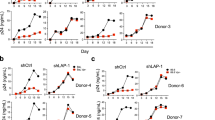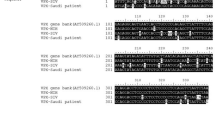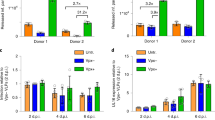Abstract
Macrophages and dendritic cells have key roles in viral infections, providing virus reservoirs that frequently resist antiviral therapies and linking innate virus detection to antiviral adaptive immune responses1,2. Human immunodeficiency virus 1 (HIV-1) fails to transduce dendritic cells and has a reduced ability to transduce macrophages, due to an as yet uncharacterized mechanism that inhibits infection by interfering with efficient synthesis of viral complementary DNA3,4. In contrast, HIV-2 and related simian immunodeficiency viruses (SIVsm/mac) transduce myeloid cells efficiently owing to their virion-associated Vpx accessory proteins, which counteract the restrictive mechanism5,6. Here we show that the inhibition of HIV-1 infection in macrophages involves the cellular SAM domain HD domain-containing protein 1 (SAMHD1). Vpx relieves the inhibition of lentivirus infection in macrophages by loading SAMHD1 onto the CRL4DCAF1 E3 ubiquitin ligase, leading to highly efficient proteasome-dependent degradation of the protein. Mutations in SAMHD1 cause Aicardi–Goutières syndrome, a disease that produces a phenotype that mimics the effects of a congenital viral infection7,8. Failure to dispose of endogenous nucleic acid debris in Aicardi–Goutières syndrome results in inappropriate triggering of innate immune responses via cytosolic nucleic acids sensors9,10. Thus, our findings show that macrophages are defended from HIV-1 infection by a mechanism that prevents an unwanted interferon response triggered by self nucleic acids, and uncover an intricate relationship between innate immune mechanisms that control response to self and to retroviral pathogens.
This is a preview of subscription content, access via your institution
Access options
Subscribe to this journal
Receive 51 print issues and online access
$199.00 per year
only $3.90 per issue
Buy this article
- Purchase on Springer Link
- Instant access to full article PDF
Prices may be subject to local taxes which are calculated during checkout




Similar content being viewed by others
References
Blankson, J. N., Persaud, D. & Siliciano, R. F. The challenge of viral reservoirs in HIV-1 infection. Annu. Rev. Med. 53, 557–593 (2002)
Steinman, R. M. & Hemmi, H. Dendritic cells: translating innate to adaptive immunity. Curr. Top. Microbiol. Immunol. 311, 17–58 (2006)
Nègre, D. et al. Characterization of novel safe lentiviral vectors derived from simian immunodeficiency virus (SIVmac251) that efficiently transduce mature human dendritic cells. Gene Ther. 7, 1613–1623 (2000)
Kaushik, R., Zhu, X., Stranska, R., Wu, Y. & Stevenson, M. A cellular restriction dictates the permissivity of nondividing monocytes/macrophages to lentivirus and gammaretrovirus infection. Cell Host Microbe 6, 68–80 (2009)
Yu, X. F., Yu, Q. C., Essex, M. & Lee, T. H. The vpx gene of simian immunodeficiency virus facilitates efficient viral replication in fresh lymphocytes and macrophage. J. Virol. 65, 5088–5091 (1991)
Guyader, M., Emerman, M., Montagnier, L. & Peden, K. VPX mutants of HIV-2 are infectious in established cell lines but display a severe defect in peripheral blood lymphocytes. EMBO J. 8, 1169–1175 (1989)
Rice, G. I. et al. Mutations involved in Aicardi-Goutières syndrome implicate SAMHD1 as regulator of the innate immune response. Nature Genet. 41, 829–832 (2009)
Crow, Y. J. & Rehwinkel, J. Aicardi-Goutieres syndrome and related phenotypes: linking nucleic acid metabolism with autoimmunity. Hum. Mol. Genet. 18 (R2). R130–R136 (2009)
Stetson, D. B., Ko, J. S., Heidmann, T. & Medzhitov, R. Trex1 prevents cell-intrinsic initiation of autoimmunity. Cell 134, 587–598 (2008)
Yang, Y. G., Lindahl, T. & Barnes, D. E. Trex1 exonuclease degrades ssDNA to prevent chronic checkpoint activation and autoimmune disease. Cell 131, 873–886 (2007)
Le Rouzic, E. et al. HIV1 Vpr arrests the cell cycle by recruiting DCAF1/VprBP, a receptor of the Cul4-DDB1 ubiquitin ligase. Cell Cycle 6, 182–188 (2007)
Srivastava, S. et al. Lentiviral Vpx accessory factor targets VprBP/DCAF1 substrate adaptor for cullin 4 E3 ubiquitin ligase to enable macrophage infection. PLoS Pathog. 4, e1000059 (2008)
Bergamaschi, A. et al. The human immunodeficiency virus type 2 Vpx protein usurps the CUL4A-DDB1DCAF1 ubiquitin ligase to overcome a postentry block in macrophage infection. J. Virol. 83, 4854–4860 (2009)
Goujon, C. et al. SIVSM/HIV-2 Vpx proteins promote retroviral escape from a proteasome-dependent restriction pathway present in human dendritic cells. Retrovirology 4, 2 (2007)
Horton, R., Spearman, P. & Ratner, L. HIV-2 viral protein X association with the GAG p27 capsid protein. Virology 199, 453–457 (1994)
Kewalramani, V. N. & Emerman, M. Vpx association with mature core structures of HIV-2. Virology 218, 159–168 (1996)
Angers, S. et al. Molecular architecture and assembly of the DDB1–CUL4A ubiquitin ligase machinery. Nature 443, 590–593 (2006)
Florens, L. & Washburn, M. P. Proteomic analysis by multidimensional protein identification technology. Methods Mol. Biol. 328, 159–175 (2006)
Pick, E. et al. Mammalian DET1 regulates Cul4A activity and forms stable complexes with E2 ubiquitin-conjugating enzymes. Mol. Cell. Biol. 27, 4708–4719 (2007)
Hrecka, K. et al. Lentiviral Vpr usurps Cul4–DDB1[VprBP] E3 ubiquitin ligase to modulate cell cycle. Proc. Natl Acad. Sci. USA 104, 11778–11783 (2007)
Ahn, J. HIV-1 Vpr loads uracil DNA glycosylase-2 onto DCAF1, a substrate recognition subunit of a cullin 4A-ring E3 ubiquitin ligase for proteasome-dependent degradation. J. Biol. Chem. 285, 37333–37341 (2010)
Hirsch, V. M. et al. Vpx is required for dissemination and pathogenesis of SIV(SM) PBj: evidence of macrophage-dependent viral amplification. Nature Med. 4, 1401–1408 (1998)
Gibbs, J. S. et al. Progression to AIDS in the absence of a gene for vpr or vpx . J. Virol. 69, 2378–2383 (1995)
Yan, N., Regalado-Magdos, A. D., Stiggelbout, B., Lee-Kirsch, M. A. & Lieberman, J. The cytosolic exonuclease TREX1 inhibits the innate immune response to human immunodeficiency virus type 1. Nature Immunol. 11, 1005–1013 (2010)
Yamashita, M., Perez, O., Hope, T. J. & Emerman, M. Evidence for direct involvement of the capsid protein in HIV infection of nondividing cells. PLoS Pathog. 3, 1502–1510 (2007)
Yamashita, M. & Emerman, M. Cellular restriction targeting viral capsids perturbs human immunodeficiency virus type 1 infection of nondividing cells. J. Virol. 83, 9835–9843 (2009)
Naldini, L. et al. In vivo gene delivery and stable transduction of nondividing cells by a lentiviral vector. Science 272, 263–267 (1996)
Manel, N. et al. A cryptic sensor for HIV-1 activates antiviral innate immunity in dendritic cells. Nature 467, 214–217 (2010)
Zhang, Y., Wen, Z., Washburn, M. P. & Florens, L. Refinements to label free proteome quantitation: how to deal with peptides shared by multiple proteins. Anal. Chem. 82, 2272–2281 (2010)
Butler, S. L., Hansen, M. S. & Bushman, F. D. A quantitative assay for HIV DNA integration in vivo . Nature Med. 7, 631–634 (2001)
Acknowledgements
We thank the Karn, McDonald and Bernstein laboratories, C. Carlin, R. Asaad, M. Reuter and A. Valentin-Torres, for reagents and help at various stages of this project. We acknowledge the excellent assistance of C. Wang with fluorescence microscopy. We also thank M. Emerman and N. Manel for HIV-2 Rod proviral constructs, F. Kirchhoff for the SIVmac 239-GFP proviral clone, M. Lederman and D. McDonald for discussions, J. Karn and M. Greenberg for discussions and comments on the manuscript. We are grateful to L. Van Aelst and D. Littman for advice, discussions and critical reading of the manuscript. This work in the J.S. laboratory was supported by NIH grants R01 AI077459 and R21 AI084694 and by Case CFAR developmental funds. S.K.S., L.F. and M.P.W. are supported by The Stowers Institute for Medical Research.
Author information
Authors and Affiliations
Contributions
K.H., C.H., M.G. and J.S. designed the study. K.H., C.H., M.G., M.K.-B., S.K.S. and J.S. performed the experiments and analysed the data. S.S., L.F. and M.P.W. provided expertise and analysed the data. All authors discussed results and edited the manuscript.
Corresponding author
Ethics declarations
Competing interests
The authors declare no competing financial interests.
Additional information
The RAW mass spectrometry and SEQUEST results files for the MudPIT analyses reported in Supplementary Table I may be downloaded from ProteomeCommons.org Tranche using the following hash: +qNEgtnB3fXlq2awdE8X67zEY8D2mQbK/tYXKaA1lWve32mRnGBMOZ3Lkoy+y9HeooRuLwE8aIvPMYEx9xqBDzciIscAAAAAAAAK0w==. This data can be accessed using the passphrase Hrecka&SAMHD1.
Reprints and permissions information is available at www.nature.com/reprints. The authors declare no competing financial interests. Readers are welcome to comment on the online version of this article at www.nature.com/nature. Correspondence and requests for materials should be addressed to J.S. (jacek.skowronski@case.edu).
Supplementary information
Supplementary Information
The file contains Supplementary Table 1 and Supplementary Figures 1-7 with legends. (PDF 4230 kb)
Rights and permissions
About this article
Cite this article
Hrecka, K., Hao, C., Gierszewska, M. et al. Vpx relieves inhibition of HIV-1 infection of macrophages mediated by the SAMHD1 protein. Nature 474, 658–661 (2011). https://doi.org/10.1038/nature10195
Received:
Accepted:
Published:
Issue Date:
DOI: https://doi.org/10.1038/nature10195
This article is cited by
-
Impaired influenza A virus replication by the host restriction factor SAMHD1 which inhibited by PA-mediated dephosphorylation of the host transcription factor IRF3
Virology Journal (2024)
-
HIV-1 Myeloid Reservoirs — Contributors to Viral Persistence and Pathogenesis
Current HIV/AIDS Reports (2024)
-
Attenuation of reverse transcriptase facilitates SAMHD1 restriction of HIV-1 in cycling cells
Retrovirology (2023)
-
Production of an interleukin-10 blocking antibody by genetically engineered macrophages increases cancer cell death in human gastrointestinal tumor slice cultures
Cancer Gene Therapy (2023)
-
Shape modeling with spline partitions
Statistics and Computing (2023)
Comments
By submitting a comment you agree to abide by our Terms and Community Guidelines. If you find something abusive or that does not comply with our terms or guidelines please flag it as inappropriate.



